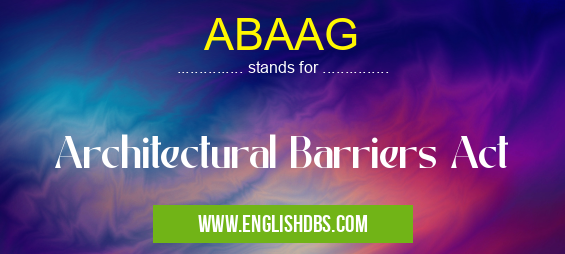What does ABAAG mean in LEGISLATION
The Architectural Barriers Act (ABA or ABAG) was enacted in 1968 to ensure that structures designed, constructed, altered, or leased with certain federal funds are accessible to people with disabilities. It has been amended several times over the years, and continues to be enforced through regulation.

ABAAG meaning in Legislation in Governmental
ABAAG mostly used in an acronym Legislation in Category Governmental that means Architectural Barriers Act
Shorthand: ABAAG,
Full Form: Architectural Barriers Act
For more information of "Architectural Barriers Act", see the section below.
Essential Questions and Answers on Architectural Barriers Act in "GOVERNMENTAL»LEGISLATION"
What are the requirements of the Architectural Barriers Act?
The ABA requires that buildings funded by certain federal agencies must be designed and constructed in accordance with certain accessibility standards. These standards include ensuring that there is an accessible entrance, exits, hallways, restrooms, floors, elevators and other building elements for people with disabilities.
Who is responsible for enforcing the Architectural Barriers Act?
The U.S. Access Board is responsible for enforcing the Architectural Barriers Act through developing and maintaining access guidelines as well as providing guidance to architects and other building professionals on how best to incorporate accessibility features into various projects. Each covered agency also has its own Office of Civil Rights responsible for monitoring compliance within its jurisdiction.
What types of buildings are covered under the Architectural Barriers Act?
Buildings constructed with certain funds administered by a covered agency such as HUD, VA or USDA are considered ‘covered' under the ABAG. Examples of covered buildings include public housing projects; public schools; assisted living facilities; hospitals; federal government offices; state courthouses; military bases and many others.
Are there any exceptions to the Architectural Barriers Act?
Yes, there are exemptions from certain requirements listed in the Guidelines issued under the ABAG including historic properties or “grandfathered-in†existing facilities where making alterations would cause undue hardship or expense due to cost or other factors. Additionally some areas may contain features which do not meet all of the requirements but could pose an undue hardship if changed such as elevators located on one side of a facility which cannot be moved without significant disruption or expense.
How can I learn more about complying with the Architectural Barriers Act?
Consulting professionals versed in both architecture/engineering and disability rights laws can help identify what needs to be done in order to comply with ABA and other disability law regulations. Additionally you can find samples of accessible design plans online as well as a variety of resources and information regarding disability access laws.
Final Words:
The purpose of Architectural Barriers Act is clear — providing meaningful access for those who have limited mobility so they can enjoy equal opportunities when it comes to accessing public buildings and services built with federal funds. By both understanding and complying with this legislation businesses can ensure that their premises comply with US Disability Access Laws while maximizing their chances of avoiding costly legal battles resulting from claims made due to non compliance.
